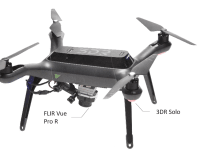

Through synergies in infrared sensing and drone platforms, we have found a new innovative way to detect hidden PFM-1 anti-personnel landmines. These particular unexploded ordnance (UXO) devices pose a difficult challenge to conventional landmine detection methods like metal detecting, because the mines are primarily composed of plastic and only weigh 75 g. As a remnant of the Soviet-Afghan War which lasted from 1979 to 1989, there are an estimated 10 million PFM-1 devices scattered throughout Afghanistan. These mines remain emplaced in isolated locations, frequently out of reach of demining NGOs and act to thwart local economic and social development. The PFM-1s are infamously referred to as “toy mines” as children often mistake the mines for toys and set off the 5-25 kg of cumulative pressure it takes to detonate them.
In order to locate these UXOs we developed a low-cost aerial platform that combines a thermal imaging system mounted to an unmanned aerial vehicle (UAV) to detect the PFM-1s temperature difference from the surrounding environment. Our results show that the PFM-1 landmines have a distinguishable thermal difference as well as differential apparent thermal inertia (DATI) in our datasets, which allows us to easily identify these landmines remotely in GIS software. Pilot studies were conducted to test different variables, such as environmental conditions, and optimal time of day to collect thermal data. Additionally, we have conducted field trials of our method by randomly dispersing 18 mines along with the aluminum KSF-1 casing to mimic an ellipsoidal minefield of 8-10 x 18-20 m simulating the mountainous Afghanistan terrain where most of the unexploded PFM-1 mines reside.
We were able to successfully identify landmines through multiple thermal infrared imagery data sets with the FLIR Vue Pro R attached to the 3DR Solo UAV flying at 10 meters above ground. Because the mines have different physical properties like reflectance, emissivity, and thermal conductivity, they heat and cool at different rate than the host geology. In the early morning hours when thermal inertia is greatest, the PFM-1 mines can be detected based on their differential thermal inertia. Because the mine has a statistically different temperature than background and characteristic shape, we are currently training a supervised learning algorithm to automate detection of the mines over large areas.
Applying our methods and technology to detect and remediate PFM-1 mines in post-conflict developing nations has the potential to save thousands of lives and significantly reduce the cost and time of mine detection, stimulating economic development.
Video
-
Awards
-
 2018 Aerospace & Defense Category Winner
2018 Aerospace & Defense Category Winner -
 2018 Top 100 Entries
2018 Top 100 Entries
Like this entry?
-
About the Entrant
- Name:Jasper Baur
- Type of entry:teamTeam members:Jasper Baur, William Frazer, Tim deSmet, Alex Nikulin
- Patent status:none





